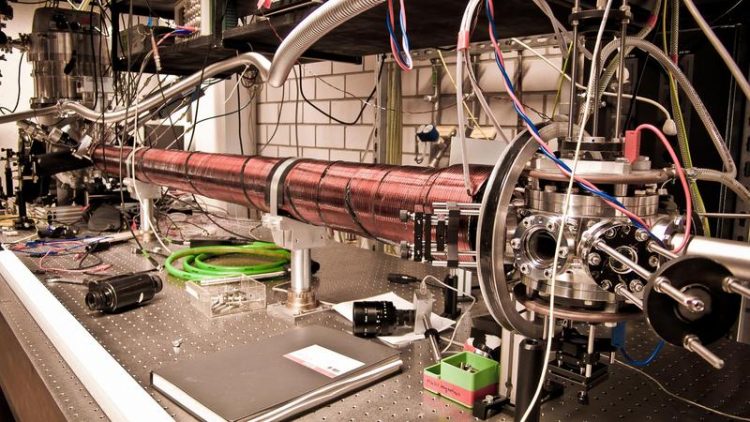Help in the Search for the Needle in the Haystack

Picture of the apparatus for 39Ar-ATTA © C. Kaup
In the earth and environmental sciences, radioactive isotopes, atom variants that decay over time, play a major role in age determination. A radioactive isotope of the inert gas argon (39Ar), for example, is used to determine the age of water or ice. Such isotopes are extremely rare, however – only a single 39Ar isotope occurs in a thousand trillion argon atoms.
Hence researchers’ attempts to isolate and detect such atoms remain the proverbial search for the needle in a haystack. Physicists at Heidelberg University have now succeeded in rendering usable an experimental method developed in basic research for ground water dating using 39Ar. According to the researchers, these results open up new perspectives in investigating glacial ice and deep-water circulation in the ocean. The results of the research were published in the journal “Geophysical Research Letters”.
The most well-known example of age determination using radioactive isotopes is radiocarbon dating, which is used for dating organic material in the environment as well as for archaeological finds. Similarly, the abundance of radioactive isotopes of the inert gases argon and krypton can be used to determine when groundwater, deep ocean water or glacial ice formed.
To detect and isolate the rare atoms from water, innovative experimental methods are used that were developed and perfected in the course of basic research on quantum mechanical systems. Scientists at the Kirchhoff Institute for Physics and the Institute of Environmental Physics at Heidelberg University were now able for the first time to use the method known as Atom Trap Trace Analysis (ATTA) to date groundwater using 39Ar.
Members of the environmental physics working group headed by Prof. Dr. Werner Aeschbach-Hertig first isolated pure argon from over 1,000 litres of groundwater. Using a specially developed ATTA apparatus, the team of Prof. Dr. Markus Oberthaler at the Kirchhoff Institute “trapped” the 39Ar atoms and detected each one.
The scientists underscore that this achievement, which culminates years of joint development work, now opens the door to a multitude of new applications for 39Ar dating. “The project is an outstanding example of how methods developed in basic research of quantum mechanical properties can open up new application horizons,” explains Prof. Oberthaler.
The study’s primary author, Dr. Florian Ritterbusch, is convinced that the measurement method can be made even better: “In principle, a litre of water should be enough for a measurement.” These advances should soon make possible the first measurements of 39Ar in glacial ice in the Alps. The researchers also believe that 39Ar has the greatest potential in the study of deep water circulation in the ocean. “To do that we have to be able to take sufficiently accurate measurements from samples of less than ten litres of water,” says Prof. Aeschbach-Hertig.
The pioneers of the new method from the Argonne National Laboratory in the U.S. organised a special ATTA workshop in Chicago in 2012 to discuss possible applications of krypton isotopes in the earth and environmental sciences. The Heidelberg ATTA collaboration is organising another such gathering to be held in March 2015. The progress made in Heidelberg in working with 39Ar once again considerably broadened the range of applications, as the researchers emphasise.
“The new method also represents an innovative expansion of the strong competence in isotope and dating methods that is present in Heidelberg and concentrated at the Heidelberg Center for the Environment,” says Prof. Aeschbach-Hertig.
Markus Oberthaler directs the Synthetic Quantum Systems working group at the Kirchhoff Institute for Physics. Werner Aeschbach-Hertig is the head of the Aquatic Systems working group at the Institute of Environmental Physics as well as director of the Heidelberg Center for the Environment (HCE).
Original publication:
F. Ritterbusch, S. Ebser, J. Welte, T. Reichel, A. Kersting, R. Purtschert, W. Aeschbach-Hertig, M.K. Oberthaler (2014). Groundwater dating with Atom Trap Trace Analysis of 39Ar. Geophysical Research Letters 41, doi: 10.1002/2014GL061120
Internet information:
http://www.kip.uni-heidelberg.de/matterwaveoptics/research/atta
http://www.hce.uni-heidelberg.de
Contact:
Prof. Dr. Werner Aeschbach-Hertig
Institute of Environmental Physics
Phone +49 6221 54-6331
aeschbach@iup.uni-heidelberg.de
Prof. Dr. Markus Oberthaler
Kirchhoff Institute for Physics
Phone +49 6221 54-5170
markus.oberthaler@kip.uni-heidelberg.de
Communications and Marketing
Press Office
Phone +49 6221 54-2311
presse@rektorat.uni-heidelberg.de
Media Contact
All latest news from the category: Physics and Astronomy
This area deals with the fundamental laws and building blocks of nature and how they interact, the properties and the behavior of matter, and research into space and time and their structures.
innovations-report provides in-depth reports and articles on subjects such as astrophysics, laser technologies, nuclear, quantum, particle and solid-state physics, nanotechnologies, planetary research and findings (Mars, Venus) and developments related to the Hubble Telescope.
Newest articles

High-energy-density aqueous battery based on halogen multi-electron transfer
Traditional non-aqueous lithium-ion batteries have a high energy density, but their safety is compromised due to the flammable organic electrolytes they utilize. Aqueous batteries use water as the solvent for…

First-ever combined heart pump and pig kidney transplant
…gives new hope to patient with terminal illness. Surgeons at NYU Langone Health performed the first-ever combined mechanical heart pump and gene-edited pig kidney transplant surgery in a 54-year-old woman…

Biophysics: Testing how well biomarkers work
LMU researchers have developed a method to determine how reliably target proteins can be labeled using super-resolution fluorescence microscopy. Modern microscopy techniques make it possible to examine the inner workings…





















